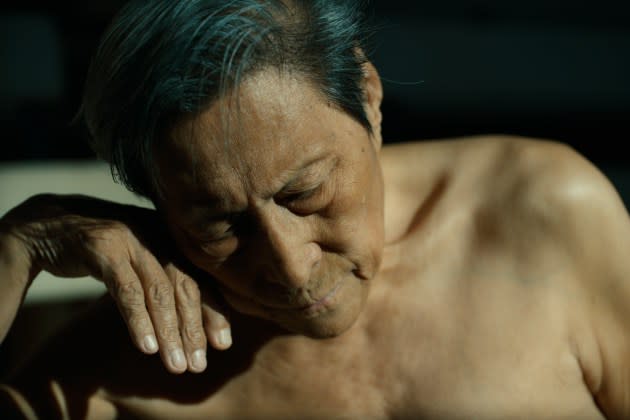‘Man in Black’ Review: Wang Bing’s Mid-Length Art Piece Is Part Memoir, Part Music, All Mesmerizing

The man is not in black. He is in nothing at all. Wearing his nakedness calmly, like a fact so obvious it requires no explanation, an 86-year-old Chinese male stands up slowly in the otherwise empty gallery of Paris’ famous Bouffes du Nord theatre. The artfully peeling, faded-grandeur interior, dim but for gathered pools of warm light, booms with the sound of his wooden seat swinging back into place, then with the creaks of the floorboards under his bare feet. This is the arresting opening to Chinese documentarian Wang Bing’s other Cannes 2023 film, “Man in Black,” a project so diametrically different from his Competition entry “Youth: Spring” that it feels hard to credit them both to the same person. Perhaps we shouldn’t. This brief but profoundly moving film represents such a consummate collaboration between director, cinematographer, editor and subject that its authorship could be recorded as a four-way tie.
Short where “Youth” is long; elegiac where “Youth” is observational; a burnished, pared-back sculpture where “Youth” is a work of surfeit and assembly, “Man in Black” can most easily, if inadequately, be described as a biographical document on Wang Xilin, a modern classical composer who endured 14 years of persecution — including beatings, torture and imprisonment — after falling out of favor with the Chinese Communist Party. He then lived through many subsequent years of ostracization by state forces that were both threatened by and covetous of his growing national and international reputation as an artist of exceptional integrity and virtuosity.
More from Variety
But you can know none of this for the first third of “Man in Black,” which is initially an abstract experience. Wang Xilin sidles along the gallery and descends a stairwell to a sudden explosion of music, as one of his remarkable compositions bursts onto the soundtrack like a wave crashing against a tide wall. The wave recedes as he steps onto the theater’s unadorned stage, moving from spotlit place to spotlit place enacting a strange dance, portrayed with a fluidity that owes much to the intuitively graceful cutting rhythms of Claire Atherton’s editing, and even more to Caroline Champetier’s astonishing camera.
The star cinematographer, who has worked with Godard and Rivette, Leos Carax and Xavier Beauvois, creates a whole new narrative by focusing on Wang Xilin’s body, unembarrassed by its scars and droops and veins, by cracked heels and warped toenails, a Francis Bacon or Egon Schiele subject lit like a Caravaggio painting. For a time, the film’s subversion exists in inviting us to map general ideas about aging and physicality, motion and posture, onto the contours of an octogenarian Chinese body.
And like in a Caravaggio, Wang Xilin’s dance (which also recalls Jonathan Glazer’s superb pandemic experiment “Strasbourg 1518,” if it were shot by Tsai Ming Liang) moves between poses that inevitably evoke attitudes of suffering, heightened by the soft patter of skin on skin as he slaps his breast or lightly pummels his torso, or as he sings a strange song that sounds like melodic anguish even though its word-shaped noises are unintelligible. Eventually Wang Xilin does talk, in real words, although the memoir section is anything but standard, as the camera again focuses on his body, his hands, his crossed legs, the way his skin folds at the joints.
Meanwhile, he recounts the painful trajectory of his life, from earnest Communist to dissident, as his belief in creative free expression brought him into conflict with a regime that cannot tolerate what it cannot control. Sometimes the director makes the seemingly counterintuitive decision to drown out his subject’s monologue with music, while continuing to subtitle what he says. But quickly it becomes clear that the symphonies and concertos — which Wang Xilin will later play seated, still naked at a glossy black Steinway grand — are also his voice, speaking in the language of crotchets and minims, as a sculptor speaks in marble and an architect speaks in brick.
The contortions of a dancing body can, without props or verbal cues, evoke pain, just as much of Wang Xilin’s music memorializes suffering. The crumbling walls of the theater make us think of structural decay, just as Wang Xilin’s aging body makes us think about the passage of time and its ravages. Music, painting, dance, theater, architecture, sculpture, literary memoir, and of course cinema — there is really no branch of the arts that “Man in Black” does not in some form illuminate, showing how all are interrelated and how the energy of one can, with determination, transfer into another. This is a quietly radical political act, a testimony now woven into so many different forms it can never again be suppressed: the devastating, riveting story of a life dedicated to the work of art, delivered as a work of art.
Best of Variety
Sign up for Variety’s Newsletter. For the latest news, follow us on Facebook, Twitter, and Instagram.
